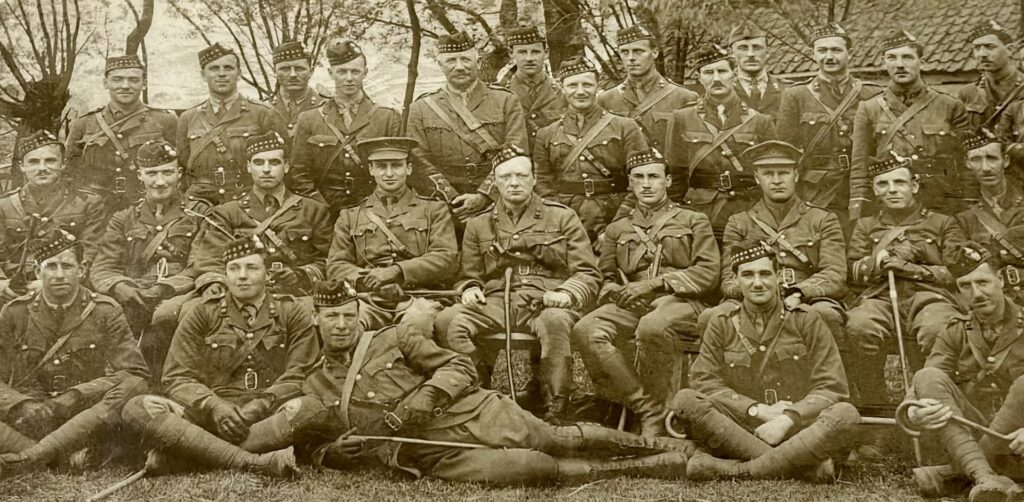HISTORY OF THE ROYAL SCOTS FUSILIERS
3rd Battalion Royal Scots Fusiliers, 1928, in Edinburgh
The infantry was raised in 1678 in response to internal instability in Scotland. At the Cardwell reforms of 1881, it officially became the County Regiment of Ayrshire in South West Scotland.
FORMATION AND EARLY YEARS
During the late 17th century, Scotland’s stability and order was in unrest from the activities of brigands, mercenaries, rebels, and particularly the Covenanters. In September 1678, Charles Erskine, the 5th Earl of Mar, was commissioned Colonel to raise a regiment to suppress the dissent among Covenantors in Scotland.
The regiment was styled The Earl of Mar’s Regiment of Foot in accordance with the custom of those days whereby a regiment took its Colonel’s name; although they were unofficially referred to as “Mar’s Old Greybreeks” or “The Duke O’Mars Greybreeks”.
The Regiment saw its first action in 1679 at the Battle of Bothwell Bridge when it helped to put down the Covenanter Rebellion which formed following the restoration of King Charles II.
BECOMING A FUSILIER REGIMENT
At some date between September 1688 and July 1691, the Regiment became a Fusilier Regiment; a special honour as it was only the second British regiment to be so styled – until the 1820s, there were only three Fusilier regiments in the Army. By 1695, it was officially known as the Scots Fusiliers. The distinction of Fusilier deriving from those elite troops armed with the new flintlock musket known as a ‘Fusil’.
In 1707, on the signing of the Treaty of Union, the name was changed to the North British Fusiliers and in 1712, the “Royal” title was granted. However, many records throughout the 18th century show the name Scots Fusiliers or Royal Scots Fusiliers was the one used in common speech.
The regiment mustered in Elgin in early 1778 and moved to Fort George. This was the first Clan regiment to be raised, wearing the kilt and plaid of the Mackenzie tartan—a tradition that continued in the trews of The Royal Highland Fusiliers.
MARLBOROUGH'S OWN
Amongst its many nicknames, perhaps the most glorious was that of “Marlborough’s Own”, commemorating its ten years active service under the Duke of Marlborough. They were also awarded The White Horse of Hanover to appear on their Colours and were honoured with the title Marlborough’s Own and the prefix Royal.
The War of Spanish Succession (1702-1712)
The 21st served under Marlborough in the Low Countries throughout the whole campaign, in, taking part in the battles of Blenheim (1704), Ramillies (1706), Oudenarde (1708), Malplaquet (1709), Bouchain (1711) and many others, before returning to Scotland in 1715.
The Battle of Blenheim (1704)
At the Battle of Blenheim, Germany, the regiment played a crucial role in turning the tide in the Spanish War of Succession. Marlborough’s Own 21st Foot helped defeat the invincible French army, kept Holy Roman Emperor Leopold on his throne and threw Bavaria out of the war. The 21st were tasked with taking the village of Blenheim and destroying the palisade. During this they took heavy musket fire and were attacked by French Cavalry; however they were determined and stood fast. The efforts of the 21st alongside the 15th Foot ensured the surrendering of the village and the taking of French captives. Following the efforts of the 21st and other British Regiments the Louis XIV French Army was no longer perceived as invincible.
THE NUMBER 21ST
The number “21st” was not in fact allocated until 1751, when numbering of regiments was generally introduced. Although the Regiment was the fourth oldest regiment of foot to be raised for the permanent army, its relatively “high” number is due to the fact that in 1694, a Board of Officers, assembled to determine the precedence of the various regiments, decided that the regiments would take precedence with effect from their date of first appearing on the English military establishment. As the Scots Fusiliers had remained in Scotland for the first ten years of its life not moving to England until 1688, it had to take precedence after many regiments which had been raised later but which had been raised in England.
Between 1713 and 1877, the Regiment was known as The 21st (Royal North British Fusilier) Regiment of Foot. From 1877-1881, they were known as The 21st (Royal Scots Fusiliers) Regiment of Foot. During the reforms of 1881, the Regiment did not suffer the indignity of being amalgamated, as it already had two regular battalions. However, it did become the County Regiment of Ayrshire, a Lowland regiment and so they were forced to adopt trews and to lose its numbering, becoming The Royal Scots Fusiliers.
CAMPAIGNS
The Regiment had a glorious history in all corners of the world: from North America to the West Indies; India to South Africa; Napoleonic & Crimean wars; the British Expeditionary Force, Gallipoli, North Africa and France & Flanders in WWI; the British Expeditionary Force, Dunkirk, the Middle East, Madagascar, Burma and North West Europe in WWII.
DID YOU KNOW?
Winston Churchill
Winston Churchill’s connection to the Royal Scots Fusiliers began during the First World War, when he was appointed Lieutenant Colonel and took command of the 6th Battalion in January 1916. He spent around six months near the Belgian town Ypres. Though his command was relatively brief, Churchill maintained his connection with the regiment, visiting the battalion on several occasions during the Second World War.


